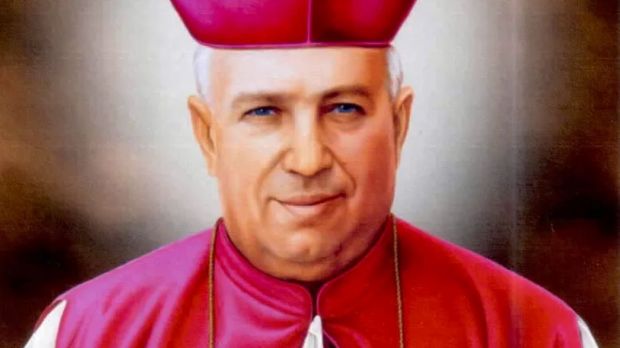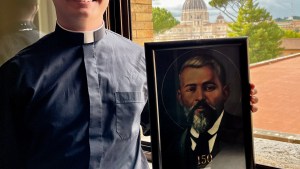Rafael Guizar y Valencia, celebrated October 24, was born in Cotija de la Paz, Mexico, in 1878. He was one of 11 children and his mom and dad, both devout Catholics, did their best to teach their children the faith.
Rafael was only nine when his mom died. Yet the faith she and her husband had instilled in Rafael and the other children continued to flourish.
Both Rafael and his brother, Antonio, aspired to the priesthood. Rafael, who was about 16 months older than Antonio, began his journey to Holy Orders first. He spent his grade school years in a religious school and also spent time with Jesuit priests. At the age of 13 he entered a minor seminary in Cotija and when he was 18 began his studies in the major seminary in Zamora. In June of 1901, at age 23, he was ordained to the priesthood. Antonio would follow his big brother and be ordained in 1903.
Father Rafael had a deep love for the Holy Eucharist and the Blessed Mother. He became the spiritual director of the seminary in Zamora and worked hard and passionately, teaching his students love of the Eucharist and an unswerving devotion to Our Lady.
A land at war
But Mexico’s political situation was increasing complicated. In 1910, with the onset of the Mexican Revolution, persecution against the Catholic Church became intense. Father Rafael Guizar, an outspoken defender of his Church and faith, was targeted by government officials.
Undeterred by government threats, he continued his work. To avoid the authorities, he was forced to carry out his duties more and more in secret. He managed to anoint the sick and administer other sacraments by disguising himself as a junk dealer, a musician, and a street vendor. He even posed as a homeopathic “medicine man.”
The authorities became more and more infuriated by Father Rafael’s actions. Their response to his continued “disobedience” to the “law” was to issue an order for him to be shot on sight. Father Rafael was thus forced to flee to the United States.
Ministry in exile
Father remained in the United States until the end of 1915. He then moved to Guatemala, where he oversaw the opening of a number of missions. His reputation as a missionary reached Cuba and he was asked to come to help establish missions there. He met with great success in Cuba and when he managed to help so many afflicted with the black plague in 1919, his reputation spread even more. Soon after, he was consecrated bishop of Veracruz.
As the revolution in Mexico officially ended, Bishop Rafael Guizar y Valencia was able to return and, on Jan. 9, 1920, took charge of his diocese. He immediately went to work visiting parishes, preaching, teaching the faith, hearing confessions and coordinating efforts to help earthquake victims.
One of Bishop Rafael’s primary concerns was the education of future priests. He worked to save an old, rundown seminary in Xalapa, renovate it, and turn it into a functioning seminary, only to have it quickly seized and closed by the anti-Catholic government. Unflappable, Bishop Rafael secretly reopened the seminary in Mexico City.
That seminary functioned clandestinely for more than 15 years. It was the only seminary that remained open during the persecutions. Remarkably, even though the danger was so great, there were always many students secretly studying there for the priesthood.
Bloody persecution of the Church
In 1926, Presidente Plutarco Calles began his bloody persecution of the Catholic Church. This resulted in the Cristero War. Bishop Guizar was forced to flee Mexico again. In 1929, the Church reached an agreement with the Mexican government whereby the Unites States would get involved as a mediator in solving the crisis. Bishop Guizar then returned to Vera Cruz and continued his ministry. He became known as “the bishop of the poor.”
In December of 1937, while visiting Cordoba, Bishop Guizar suffered a heart attack. He still managed the diocese and celebrated Mass every day. He passed away on June 6, 1938. He had been a bishop for 19 years.
Nine of Bishop Rafael’s years as a priest and bishop had been spent in exile.
His feast day is celebrated on October 24, making him one of the relatively few saints who have a feast that is other than the day of their death, and birth into eternity. This date was requested because there was already a local custom of visiting his grave on October 24, which in the older liturgical calendar, was the feast of the Archangel Rafael, and thus the saint’s name-day.
Pope St. John Paul II beatified Bishop Rafael on Jan. 29, 1995. He was canonized by Pope Benedict XVI on Oct. 15, 2006.
St. Rafael Guizar y Valencia, thank you for your inspiration and courage, and please pray for us.
LEARN MORE
*1910 Mexican revolution begins
*1917 Anti-clerical Mexican Constitution is ratified
*1920 Mexican revolution ends
*1924 Plutarco Calles becomes president and begins to enforce the anti-clerical provisions of the Constitution
*1926-1929 Cristero War
St. Rafael Guizar y Valencia was in exile from 1915 thru 1920 and from 1926 thru 1929.
The companion book to the movie For Greater Glory provides an in-depth look at the Cristero War, as well as a list of some of the many saints God raised up during that time.


